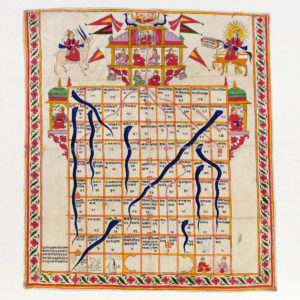Snakes (or is it Chutes?) and Ladders
Did you know the game commonly known as Chutes and Ladders is derived from an ancient Indian board game that taught life’s lessons by depicting one’s progression through life as virtuous and forward-moving/climbing via ladders, or sinful and backward-moving/falling via snakes? The version that most of us play also has a numbered 10 X 10 grid that progresses the player forward from 1-100. If you are lucky, you might land at the bottom rung of a ladder and then you get to climb to the top of that ladder. This moves you ahead very quickly. In turn, if you are unlucky, you might land at the top of a slide (chute) and you are then forced to slide down to the bottom of the slide. This slows you down quite a bit.
The version that most of us play also has a numbered 10 X 10 grid that progresses the player forward from 1-100. If you are lucky, you might land at the bottom rung of a ladder and then you get to climb to the top of that ladder. This moves you ahead very quickly. In turn, if you are unlucky, you might land at the top of a slide (chute) and you are then forced to slide down to the bottom of the slide. This slows you down quite a bit. 
This is an interesting choice for young children who have already established a solid concept of one-to-one correspondence. Successful play requires that children can determine the number rolled on the die, and then ability to count that many squares, in the right direction. This is further complicated by reversing rows of numbers – one reading left to right – and the next reading right to left.
You might find that this is either intuitive, children move from right to left counting from 1-10 and then move to the next row and reverse operations from 11-20. But you might also find that it is counter-intuitive. Readers want to count from left to right and then go back to the left immediately and continue moving from left to right.
This alone, is a complicated experience for young children. Now they have to figure out how to deal with the possibility of falling behind when they might have been ahead. These are some of life’s hard lessons.
This game is a classic and is a great choice for children who are counting. It is exciting for them to get to 100. 
This is a great game for kids because it helps the young kids establish their own Independence when it comes time for them to get back up on their own in life
To bridge background knowledge as I begin to introduce board games like this to my class, I’m considering having players pick a card from our familiar deck of numeral/dot cards (instead of rolling a die) and counting the dots on their card before counting spaces on the game board. Once the children are comfortable with the process of taking turns and counting the gameboard spaces, I’ll introduce the die – and have them roll it in a shoebox.